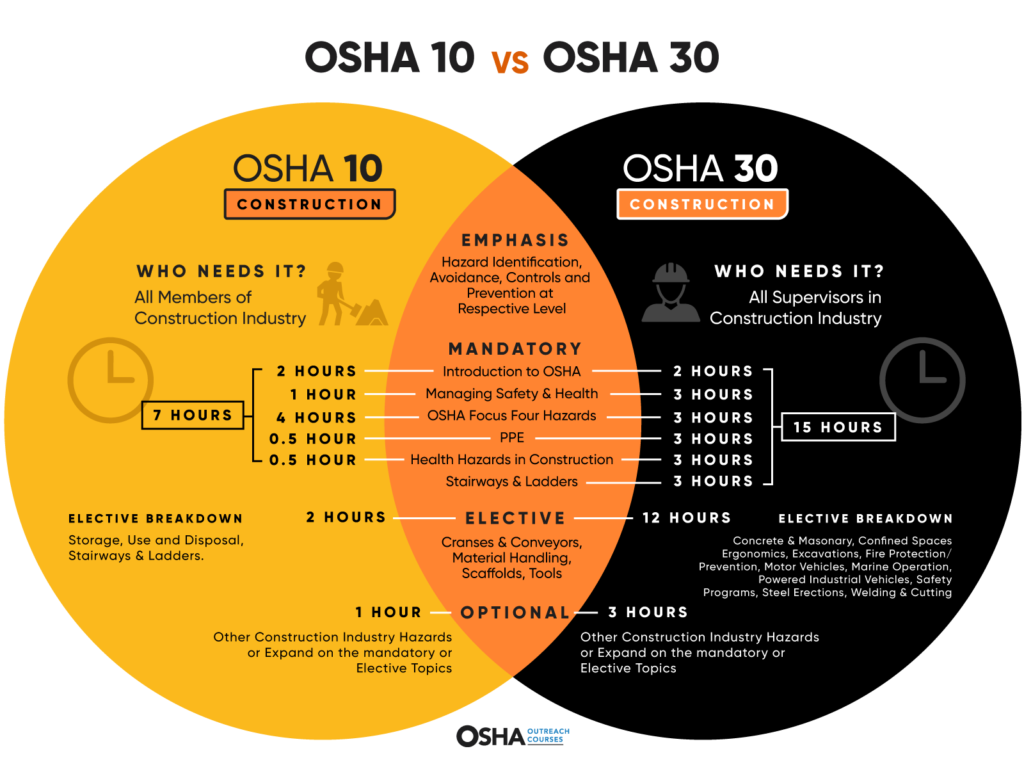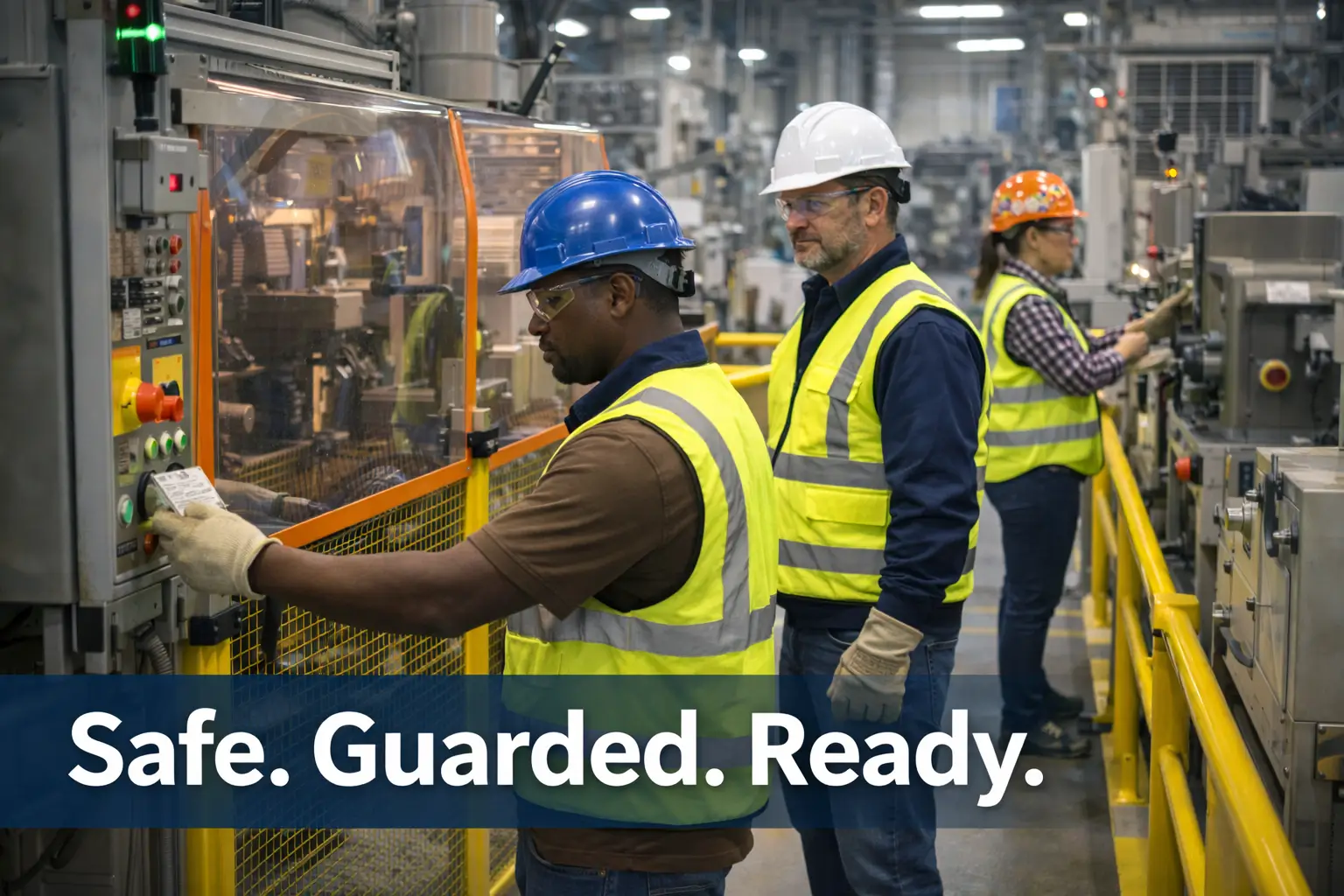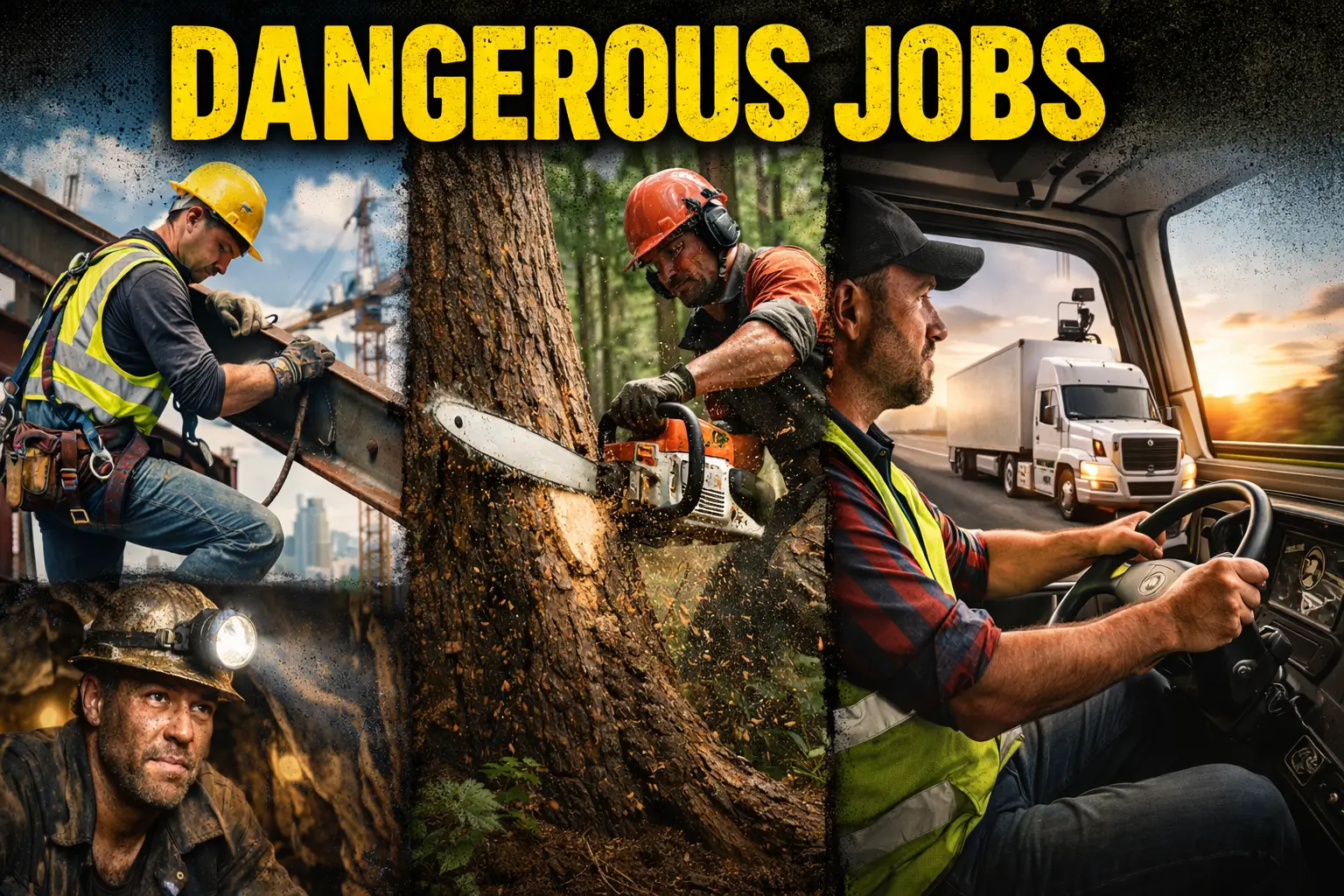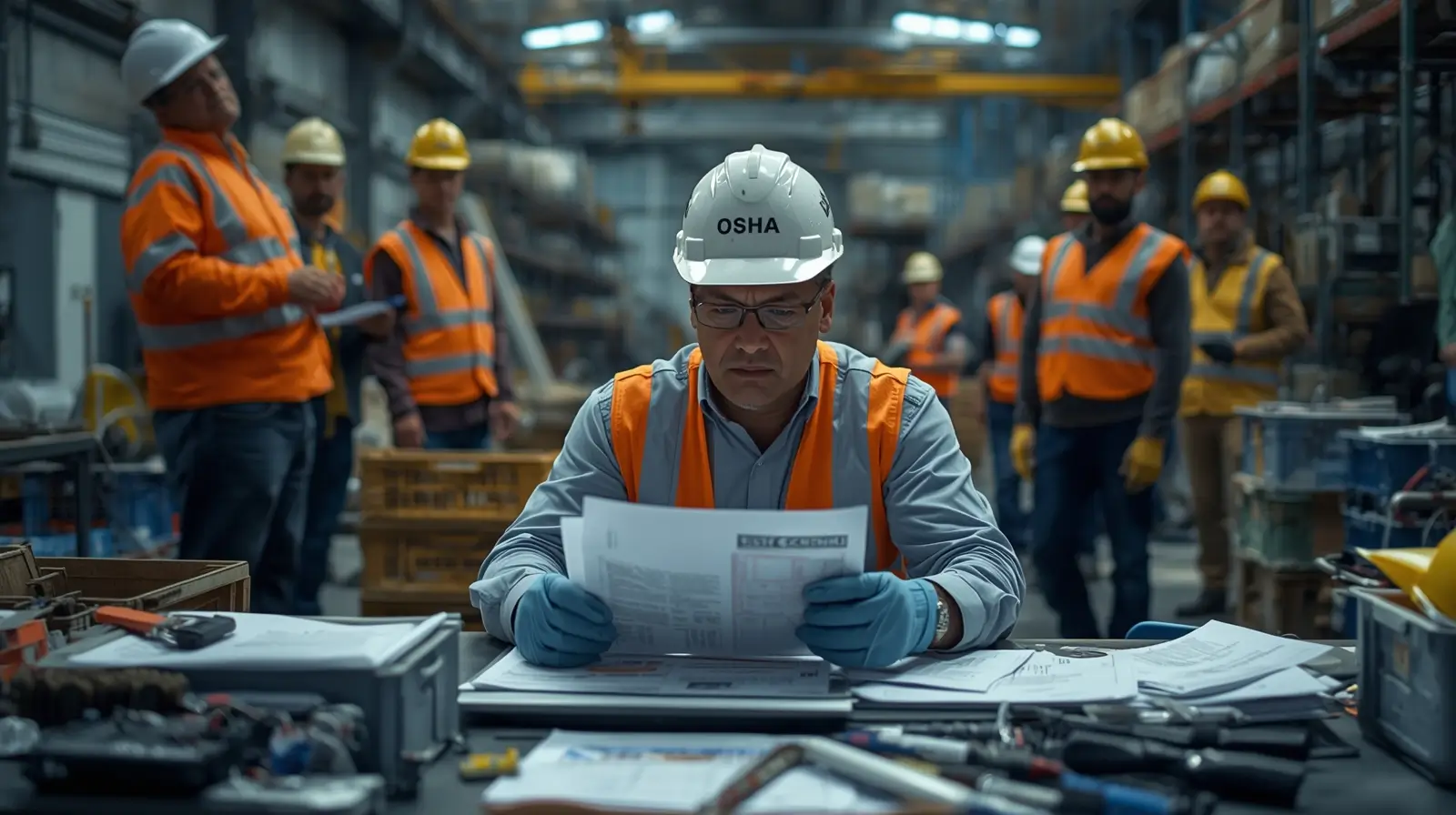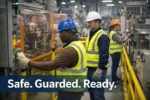OSHA 10 vs 30
Difference Between OSHA 10 and 30 Course
OSHA Outreach Training courses are usually provided in two popular forms; the OSHA 10-Hour and 30-Hour course. Of course, the 30-hour course is more detailed and provides a broader overview of workplace safety practices, standards, and regulations.
However, there’s a lot more to how these courses differ from one another. In particular, both of these programs are designed for individuals at different levels across the industry. In this article, we will shed light on the differences between OSHA 30-Hour and 10 courses.
The 10 and 30-Hour Training
The OSHA 10-Hour Construction online training leads to a valid DOL/OSHA 10-Hour Card. This online training course explains identifying, mitigating, and eliminating workplace risks. In addition, you will learn about OSHA guidelines for construction; and how to receive the OSHA DOL Card to meet your company’s protection level needs.
The OSHA 30-Hour training construction course is for higher management construction employees. This course is necessary for jobs in new building and infrastructure design, demolition, and significant rebuilding projects. The 30 hours training program has 84 topics. In addition, contractors, project managers, safety managers, and coordinators can benefit from this training.
OSHA 10 vs 30
Difference Between OSHA 10 and 30 Course
OSHA Outreach Training courses are usually provided in two popular forms; the OSHA 10-Hour and 30-Hour course. Of course, the 30-hour course is more detailed and provides a broader overview of workplace safety practices, standards, and regulations.
However, there’s a lot more to how these courses differ from one another. In particular, both of these programs are designed for individuals at different levels across the industry. In this article, we will shed light on the differences between OSHA 30-Hour and 10 courses.
The 10 and 30-Hour Training
The OSHA 10-Hour Construction online training leads to a valid DOL/OSHA 10-Hour Card. This online training course explains identifying, mitigating, and eliminating workplace risks. In addition, you will learn about OSHA guidelines for construction; and how to receive the OSHA DOL Card to meet your company’s protection level needs.
The OSHA 30-Hour training construction course is for higher management construction employees. This course is necessary for jobs in new building and infrastructure design, demolition, and significant rebuilding projects. The 30 hours training program has 84 topics. In addition, contractors, project managers, safety managers, and coordinators can benefit from this training.
Understanding The Main Difference Between OSHA 10 and 30
Comparing 30 & 10-hour Construction
Do you need OSHA 10 or 30? First, you need to understand the main difference between OSHA courses and their categories:
The 10-hour training is designed for entry-level and non-supervisory employees. The construction course, for example, required time spent on the Focus Four Fall Protection, Electrical Safety, Struck By, Caught Between – Staying Out of the Line of Fire. When comparing the 10 to the 30-Hours, the time needed for “Introduction to OSHA” remains the same, while the time required for Focus Four varies from 4 to 6 hours. The condition “Managing Safety and Health” has been added.
PPE and construction health hazards have increased from half an hour to two hours. Stairways and Ladders have been made required. A host of new subjects have been added to the catalog of electives. Under these conditions, the teacher has the authority to tailor the course to your specific needs. It is intended to serve as awareness training, through which workers become acquainted with common occupational hazards. They hear about recognizing, avoiding, mitigating, and preventing threats. Staff can also read about their rights, how to file a lawsuit about OSHA breaches, and their employers’ obligations.
One of the disadvantages of online training; there is no program customization, and manufacturing workers follow the same training courses as warehouse staff. For example, a masonry worker receives similar training as a bridge painter.
Education saves lives. You must regularly test your employees to ensure adequate training. A non-relevant subject makes a student’s eyes glaze over.
Do You Need Both?
No. If you have completed only 30 hours training, you don’t need OSHA 10 training. Similarly, the 10-hour training is not a prerequisite to the 30-hour training.
Start Your Training Now
Doesn’t matter whether you need an 10-Hour course or a 30-Hour course, we have both available for cost-efficient prices.
Understanding The Main Difference Between OSHA 10 and 30
Comparing 30 & 10-hour Construction
Do you need OSHA 10 or 30? First, you need to understand the main difference between OSHA courses and their categories:
The 10-hour training is designed for entry-level and non-supervisory employees. The construction course, for example, required time spent on the Focus Four Fall Protection, Electrical Safety, Struck By, Caught Between – Staying Out of the Line of Fire. When comparing the 10 to the 30-Hours, the time needed for “Introduction to OSHA” remains the same, while the time required for Focus Four varies from 4 to 6 hours. The condition “Managing Safety and Health” has been added.
PPE and construction health hazards have increased from half an hour to two hours. Stairways and Ladders have been made required. A host of new subjects have been added to the catalog of electives. Under these conditions, the teacher has the authority to tailor the course to your specific needs. It is intended to serve as awareness training, through which workers become acquainted with common occupational hazards. They hear about recognizing, avoiding, mitigating, and preventing threats. Staff can also read about their rights, how to file a lawsuit about OSHA breaches, and their employers’ obligations.
One of the disadvantages of online training; there is no program customization, and manufacturing workers follow the same training courses as warehouse staff. For example, a masonry worker receives similar training as a bridge painter.
Education saves lives. You must regularly test your employees to ensure adequate training. A non-relevant subject makes a student’s eyes glaze over.
OSHA 10 vs 30
Difference Between OSHA 10 and 30 Course
OSHA Outreach Training courses are usually provided in two popular forms; the OSHA 10-Hour and 30-Hour course. Of course, the 30-hour course is more detailed and provides a broader overview of workplace safety practices, standards, and regulations.
However, there’s a lot more to how these courses differ from one another. In particular, both of these programs are designed for individuals at different levels across the industry. In this article, we will shed light on the differences between OSHA 30-Hour and 10 courses.
The 10 and 30-Hour Training
The OSHA 10-Hour Construction online training leads to a valid DOL/OSHA 10-Hour Card. This online training course explains identifying, mitigating, and eliminating workplace risks. In addition, you will learn about OSHA guidelines for construction; and how to receive the OSHA DOL Card to meet your company’s protection level needs.
The OSHA 30-Hour training construction course is for higher management construction employees. This course is necessary for jobs in new building and infrastructure design, demolition, and significant rebuilding projects. The 30 hours training program has 84 topics. In addition, contractors, project managers, safety managers, and coordinators can benefit from this training.
Understanding The Main Difference Between OSHA 10 and 30
Comparing 30 & 10-hour Construction
Do you need OSHA 10 or 30? First, you need to understand the main difference between OSHA courses and their categories:
The 10-hour training is designed for entry-level and non-supervisory employees. The construction course, for example, required time spent on the Focus Four Fall Protection, Electrical Safety, Struck By, Caught Between – Staying Out of the Line of Fire. When comparing the 10 to the 30-Hours, the time needed for “Introduction to OSHA” remains the same, while the time required for Focus Four varies from 4 to 6 hours. The condition “Managing Safety and Health” has been added.
PPE and construction health hazards have increased from half an hour to two hours. Stairways and Ladders have been made required. A host of new subjects have been added to the catalog of electives. Under these conditions, the teacher has the authority to tailor the course to your specific needs. It is intended to serve as awareness training, through which workers become acquainted with common occupational hazards. They hear about recognizing, avoiding, mitigating, and preventing threats. Staff can also read about their rights, how to file a lawsuit about OSHA breaches, and their employers’ obligations.
One of the disadvantages of online training; there is no program customization, and manufacturing workers follow the same training courses as warehouse staff. For example, a masonry worker receives similar training as a bridge painter.
Education saves lives. You must regularly test your employees to ensure adequate training. A non-relevant subject makes a student’s eyes glaze over.
Do You Need Both?
No. If you have completed only 30 hours training, you don’t need OSHA 10 training. Similarly, the 10-hour training is not a prerequisite to the 30-hour training.
Start Your Training Now
Doesn’t matter whether you need an 10-Hour course or a 30-Hour course, we have both available for cost-efficient prices.
Do You Need Both?
No. If you have completed only 30 hours training, you don’t need OSHA 10 training. Similarly, the 10-hour training is not a prerequisite to the 30-hour training.
Start Your Training Now
Doesn’t matter whether you need an 10-Hour course or a 30-Hour course, we have both available for cost-efficient prices.


